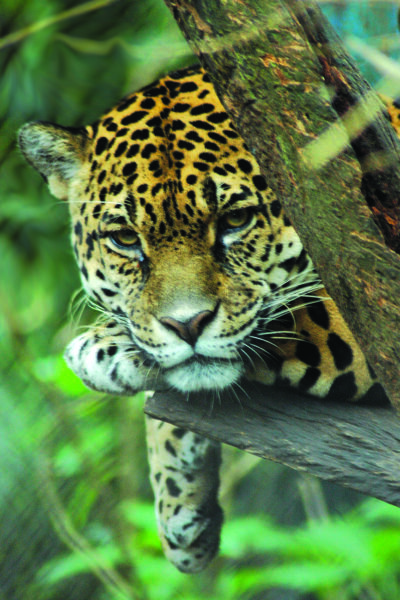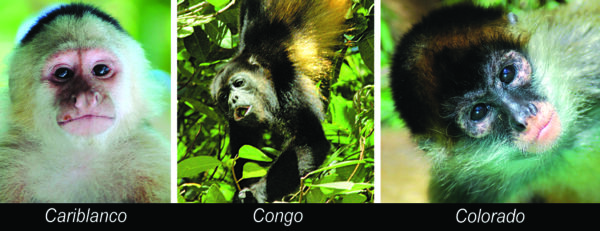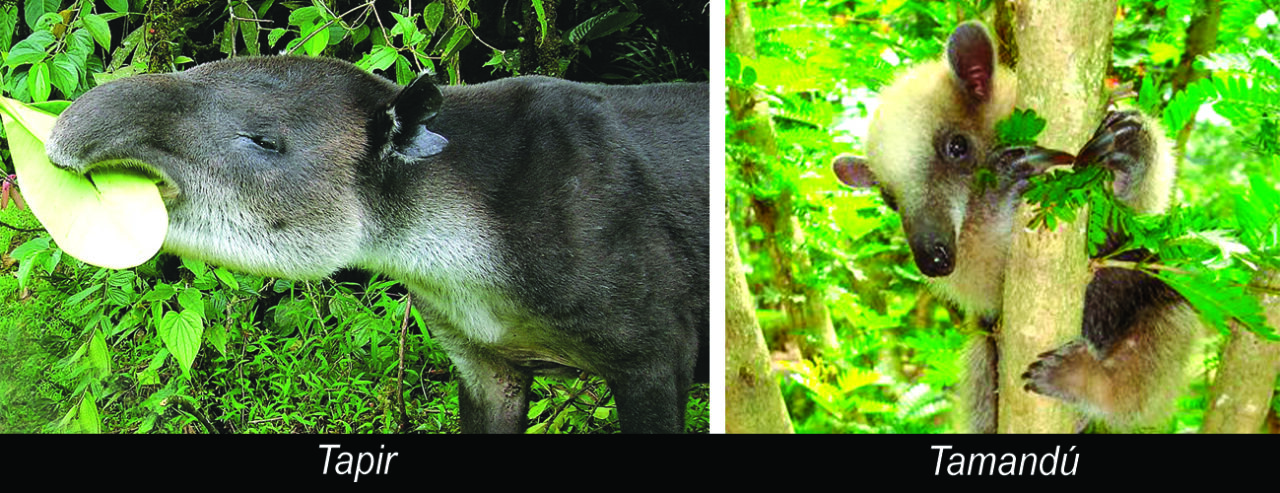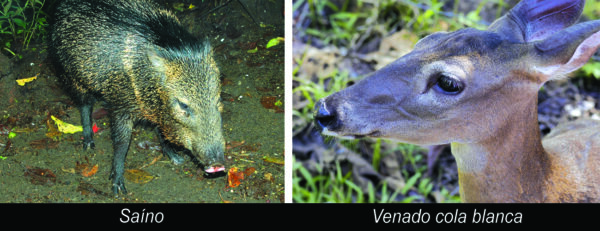
Mammals
The rich varieties of ecosystems that exist in the Caribbean allow the life of many species of terrestrial and marine mammals. These are the mammals main characteristics, with some exceptions: They are warm blooded and their body temperature is constant while varying the temperature outside, breathe with lungs and have the body covered with hair. Their limbs are often leg shaped. The aquatic ones such as dolphins and whales have fins, and the flying ones such as bats have membranes in the forelimbs. This is a list of the most characteristical mammals we can find in the Costa Rican Caribbean
• Primates
In the Caribbean there are 3 primate species, of diurnal habits which are fairly easy to spot. The White-faced or Capuchin (Cebus capucinus) is small, can weigh up to 3.5 kg., has a black body and white face, chest and shoulders. It lives in herds of up to 40 individuals and feed on fruit, flowers, seeds, insects, worms, reptiles and amphibians. The Congo or Howler Monkey (Alouatta palliata), is black, up to 50 cm. and its weight is between 4.5 and 10 kg. It is characterized by the strong cries it produces are livesd in groups of 10 to 20 individuals and feeds on sprouts. The Spider Monkey (Ateles geoffroyi) may meassure more than 1.3 meters. including the tail, its weight is between 6 and 9 kg. and has very long arms, legs and tail. There are two varieties, one black and one brown, both feed on leaves and fruits.

• Sloths
They are medium-sized herbivores; we find two species that are distributed throughout the Caribbean. The most common is the Three-toed Sloth (Bradypus variegatus), short-nosed, gray hair, three toes on their front paws and of daily habits. The other one, the Two-toed Sloth (Choloepus hoffmanni), is of brown colour, elongated snout, two toes on his front legs and nocturnal habits.

• Felines
In Costa Rica there are 6 species of felines, which are active both day and night and hard to see. The Jaguar (Panthera onca) is the largest of them, golden yellow colour with black circular spots, and reaching 150 cm. length of its body and 80 cm. length of its tail. It weighs between 70 and 100 kg., and feeds on wild pigs, peccaries, tapirs, deers and turtles, as well as monkeys, alligators, fish and occasionally cattle.
The Puma (Puma concolor) reaches about 112 cm. long, and 80 cm. of tail, weighs about 40 kg. It is found in almost all protected areas of the country with over 10,000 ha. extension. Their main prey is the white-tailed deer. The Ocelot (Leopardus pardalis) reaches 75 cm. length plus the tail and weighs 10 kg., lives in the Braulio Carrillo National Park and in the humid forests of the Caribbean coast. The Jaguarundi (Herpailurus yagouaroundi) is a small felid of 65 cm. brown or black coloured that lives in almost every part of the country and feeds on birds and small mammals. The Margay (Leopardus wiedii) has a body color between brown and gray with black open spots, the snout is short, has big eyes and a very long tail, it is nocturnal and feeds on birds, monkeys, lizards and rodents.

• Tapir
There is a kind of tapir in Costa Rica, the Northern Tapir (Tapirus bairdii), the largest wild mammal in the country, reaching up to 220 cm. long, 1 meter tall and over 300 kg. weight. They are relatively abundant, especially in the Braulio Carrillo National Park.
• Anteaters
Common in the lowlands and middle elevations of the Caribbean, there are 3 species, the most common is the Tamandua (Tamandua mexicana), of black-yellow colour and prehensile tail, the Giant Anteater (Myrmecophaga tridactyla), which is very big, and Silky Anteater (Cyclopes didactylus) inhabits the lowlands of the country. The diet of these animals is based on ants and termites.

• Raccoons
There are several species in Costa Rica, a very common one is the Northern Raccoon (Procyon lotor), silver-gray coloured, darker at the center of the back, with long ringed tail, pointed nose and a black spot in the cheeks and eyes forming a mask. It is nocturnal and their diet consits on crabs and fruits.
• Coati
The Coati or Pizote (Nasua narica) lives across the country, has a reddish brown body, measuring 110-120 cm. lenght, weighs around 6 kg. has diurnal habits and eats fruit and meat. It is an important seeds disseminator.

• Peccaries
There are two peccary species, the Collared Peccary (Tayassu tajacu), which is characterized by a band of white hair around iis neck and a size that reaches 90 cm. lenght, being an animal that lives in groups of 2 to 20 individuals . White-lipped Peccary (Tayassu peccary) exceeds 1 meter in length and reaches up to 60 cm. hight, it has diurnal habits and lives in groups of up to 300 individuals. It is found only in the rainforests and the Tortuguero National Park.
• Deers
There are two species, White-tailed Deer (Odocoileus virginianus), more common and easy to spot, is about 130 cm. lenght and feeds on bark, leaves and fruits, and Red Brocket Deer (Mazama americana) which has a length of 110 cm. Their main predators are jaguars, pumas, coyotes, alligators and boa constrictors.

• Rodents
There are around 40 species distributed throughout the Caribbean, are easy to spot during day or night. One of the most common is the Agouti (Dasyprocta punctata), brown coloured of around 50 cm. length, inhabits forests to 1,800 msnm. and feeds on fruit. Tepezcuintle (Agouti paca) is somewhat larger than the Agouti, around 70 cm. length. The Squirrel (Sciurus variegatoides) has diurnal habits and is arboreal, very fury tail, feeds on seeds that sometimes bury and afterwords forget helping with the forest´s reforestation.
• Weasels
In Costa Rica there are 9 species of marsupials, one of the best known is the Common Opossum (Didelphis marsupialis) which reaches nearly a meter length tail included. Another species is the Four-eyed Opossum (Philander opossum) a little smaller in size, renowned for his black face with two white marks on their eyes, and fine gray fur.

• Bats
They are the most abundant mammals, with 116 species, most of nocturnal habits, arboreal and frugivorous, as the Fruit Bat (Artibeus lituratus) and Salvin Bat (Chiroderma salvini). There are 3 species of vampire bats, the Common Vampire (Desmodus rotundus), the Hairy-legged Vampire (Diphylla ecaudata) and White-winged Vampire (Desmodus youngi). One of the most unique vampire species and easy to sport is the Greater Bulldog Bat (Noctilio leporinus) which feeds on fish and is one of the largest bats.
• Marine Mammals
In the Caribbean there are three dolphin species, the Atlantic Spotted Dolphin (Stenella attenuata), 2 to 2.5 meters. in length and between 90 and 165 kg. weight. It has a characteristic dark gray with small white spots mark on the back, a dark patch in the eye, and the dorsal fin is sickle-shaped. They live in groups, is a good swimmer and has a top speed of 28 km / h. The Bottlenose Dolphin (Tursiops truncatus), measures from 2 to 4 mts. and weighs between 150 and 650 kg. Its body is long and robust, and elongated dorsal fin. Usually lives in groups of 10 to 25 individuals. It travels at 18 km/h. and likes to swim in the waves created by boats.
The Tucuxi Dolphin (Sotalia fluviatilis), is the world’s smallest, measuring less than two meters and of 35 to 40 kg. weight. The dorsal fin is short and triangular with a curved tip. It is a slow swimmer and performs acrobatics and jumps. It is a loneler though living in groups of 2 or 3 individuals.


Fotografias de Paco Salmerón
Texto de Juan Carlos Lorite y Paco Salmerón